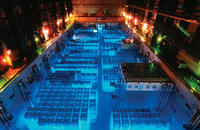-
Industrial Defender offers new backup and disaster recovery services
Industrial Defender the acquires Fandotech LLC, a provider of backup and disaster recovery services, enabling it to debut Survive Services, the company’s new backup and disaster recovery offering for ICS
-
-
B612 Foundation unveils first privately funded deep space mission
A private group plans to launch its own space telescope and place it in orbit around the sun; the mission will collect information about Earth-threatening asteroids, but also look for asteroids that may contain valuable raw materials for mining
-
-
DHS awards Unisys IT services contract with a total potential value of $3 billion
Unisys among thirty companies to compete for task orders for infrastructure support and operations and maintenance services under $3 billion contract; Unisys shares were trading sharply higher Wednesday morning after the company released the news about the contract
-
-
Forecast: sharp increase in world oil production capacity, risk of price collapse

Oil production capacity is surging in the United States and several other countries at such a fast pace that global oil output capacity is likely to grow by nearly 20 percent by 2020, which could prompt a plunge or even a collapse in oil prices; the growth in oil output owes largely to a combination of high oil prices and new technologies such as hydraulic fracturing that are opening up vast new areas and allowing extraction of “unconventional” oil such as tight oil, oil shale, tar sands and ultra-heavy oil
-
-
Crowd dynamics explains disaster at cultural, sports events
Physicists investigating a recent crowd disaster in Germany found that one of the key causes was that at some point the crowd dynamics turned turbulent, akin to behavior found in unstable fluid flows
-
-
Long-term priorities for U.S. nuclear physics program
Nuclear physics is a discovery-driven enterprise aimed at understanding the fundamental nature of visible matter in the universe; for the past hundred years, new knowledge of the nuclear world has also directly benefited society through many innovative applications
-
-
CSC, Knight Point Systems receive DHS mentor- protégé award
DHS Office of Small and Disadvantaged Business Utilization (OSDBU) selected two Virginia-based companies, CSC and Knight Point Systems, to receive the 2012 DHS Mentor-Protégé Team of the Year award
-
-
Predicting wave power helps double marine energy

The energy generated from the oceans could be doubled using new methods for predicting wave power; researchers have devised a means of accurately predicting the power of the next wave in order to make the technology far more efficient, extracting twice as much energy as is currently possible
-
-
Loo turns poo into power
Researchers have invented a new toilet system that will turn human waste into electricity and fertilizers and also reduce the amount of water needed for flushing by up to 90 percent compared to current toilet systems
-
-
Recycling nuclear fuel offers plentiful, clean energy

Currently, only about 5 percent of the uranium in a fuel rod gets fissioned for energy in a nuclear reactor; after that, the spent rods, still containing about 95 percent uranium fuel, are taken out of the reactor and put into permanent storage; researchers say that recycling used nuclear fuel could produce hundreds of years of energy from just the uranium that has already been mined, all of it carbon-free
-
-
nCircle’s new solution offers coverage for six SCADA suppliers
Critical infrastructure is designated by DHS and the North American Reliability Corporation (NERC) as the assets, systems, and networks so vital to the United States that their incapacitation or destruction would have a debilitating effect on security, national economic security, and public health or safety; nCircle offers a security solution which covers vulnerabilities from six SCADA equipment suppliers
-
-
FTC charges businesses exposed sensitive information on P2P file-sharing networks
The U.S. Federal Trade Commission (FTC) has charged two businesses with illegally exposing the sensitive personal information of thousands of consumers by allowing peer to peer file-sharing software to be installed on their corporate computer systems
-
-
Forensic research using DNA sequencing technology
The Ion Personal Genome Machine (PGM) Sequencer translates chemical sequencing information directly into digital form by using semiconductor technology; it enables the analysis of ninety-six samples in one run, allowing forensic practitioners to obtain more information from the samples they process; the sequencer is suitable for a wide array of forensic identification applications, including missing persons identifications, mass disaster work, interpretations of complex mixtures, and bio-defense
-
-
Larger role for renewable energy in U.S. future than previously thought

Renewable electricity generation from technologies that are commercially available today, in combination with a more flexible electric system, is more than adequate to supply 80 percent of total U.S. electricity generation in 2050 while meeting electricity demand on an hourly basis in every region of the country; new study finds that renewable generation could play a more significant role in the U.S. electricity system than previously thought
-
-
Gun shop which sold gun to Virginia Tech killer closes its doors

Madison, Wisconsin-based online weapon dealer TGSCO, which gained notoriety after it was disclosed that it had sold guns to three individuals – including the Virginia Tech killer — who then went on to commit mass killings, closed its doors last month
-
More headlines
The long view
Factories First: Winning the Drone War Before It Starts
Wars are won by factories before they are won on the battlefield,Martin C. Feldmann writes, noting that the United States lacks the manufacturing depth for the coming drone age. Rectifying this situation “will take far more than procurement tweaks,” Feldmann writes. “It demands a national-level, wartime-scale industrial mobilization.”
Trump Is Fast-Tracking New Coal Mines — Even When They Don’t Make Economic Sense
In Appalachian Tennessee, mines shut down and couldn’t pay their debts. Now a new one is opening under the guise of an “energy emergency.”
Smaller Nuclear Reactors Spark Renewed Interest in a Once-Shunned Energy Source
In the past two years, half the states have taken action to promote nuclear power, from creating nuclear task forces to integrating nuclear into long-term energy plans.
